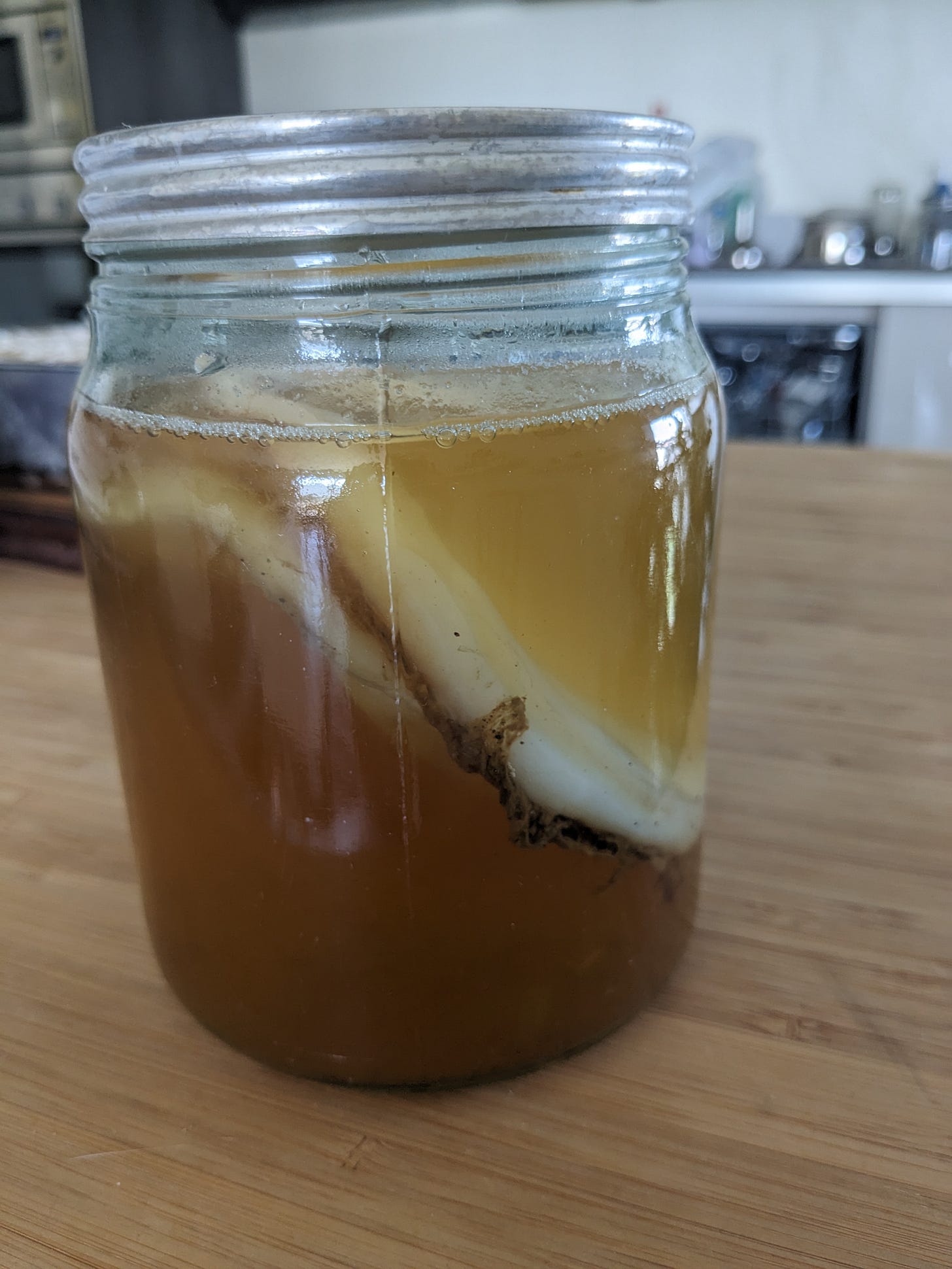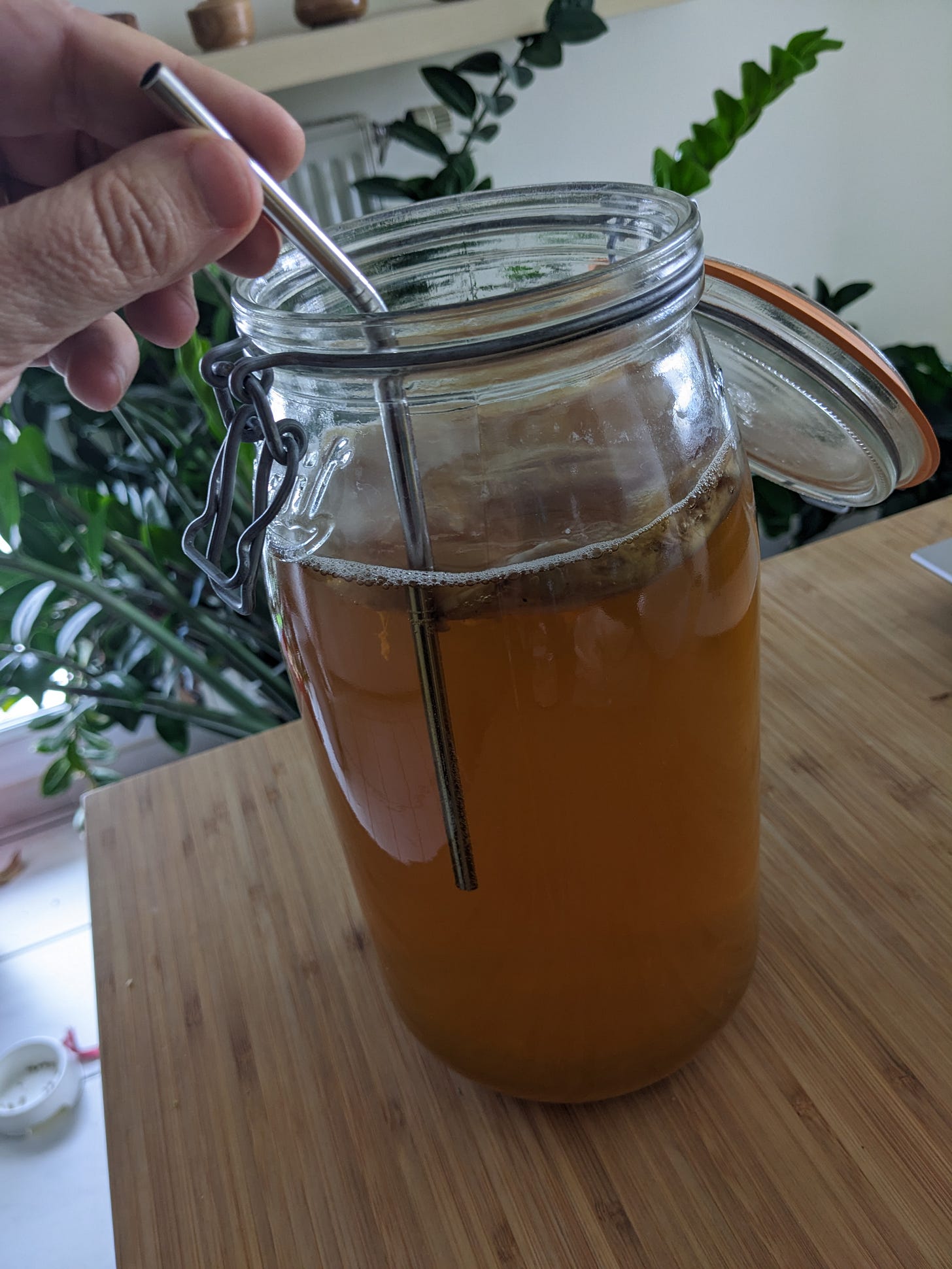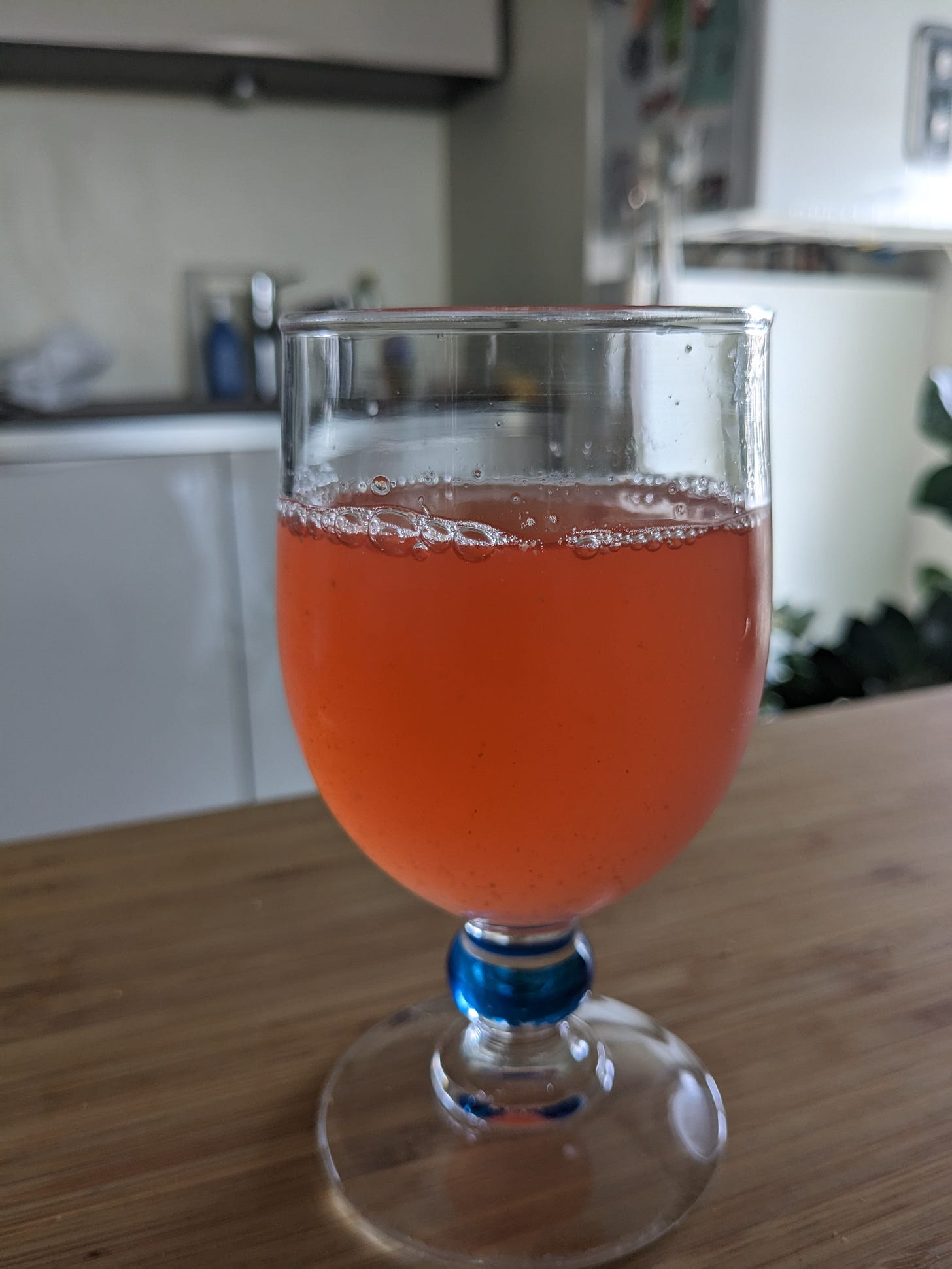We had the in-laws over for lunch a while ago – the family of Christian’s daughter’s partner. They’ve been dating for three and a half years and living together for one, and it seems likely to all of us that they will be together for a long time.
For those curious about the apéro menu (see this post), we had champagne and tartines (slices of bread with tapenade or rillettes de poulet) for the adults, orange juice or coca cola and store brand Pringles (sour cream and onion) for those under 18 and those (our future son-in-law) who abstain completely from alcohol for health reasons.
This post is not about our meal as much as it is about probiotics. We hadn’t even started the apéro before there was a conversation in the kitchen about what was in this jar on the counter:
Christian’s son loves to tell visitors that, “IT’S ALIVE! That thing floating on the top is alive and it’s making the drink! Would you drink it?”
“That thing” is a SCOBY, a symbiotic colony of bacteria and yeast, and the drink is kombucha. Most French people have never heard of kombucha, so I had to explain what it is, that it’s a probiotic, and that I make my own. That led to an exploration of the refrigerator and the five other living cultures inside it, not even counting yogurt. So here we go on a probiotic tangent, starting with kombucha.
I make great kombucha, if I do say so myself. My daughters would accuse me of bragging at this point, but they would also willingly admit that my kombucha is better than most store-bought brands.
I’ve been making it for a long time – between ten and fifteen years, I don’t remember exactly when I started. Like many people in the early days, I discovered kombucha through GT Dave’s, the only brand that was widely available at that time. I loved it, and believed that it was good for me, but I really couldn’t afford to buy it regularly. My mom told me that you could make your own, starting from a commercial bottle, and that’s what I did.
My SCOBY, now a large and healthy teenager, started from the nearly invisible filaments in the bottom of a bottle of GT’s Original. I fed it sugared tea, first in a pint jar, then in a quart, and finally in the half-gallon jars that I use as my household scale kombucha factory today.
It’s often cold enough in my house that I need to keep the jar on a seedling heat mat: one year I had it on the counter against the north wall of my house without a heating mat and the SCOBY nearly died.
It took me a long time and a lot of experimentation to get the secondary fermentation right. This happens after bottling, at the end of the process, and it’s what give kombucha its carbonated fizz.
I brought a couple of layers of my SCOBY across the Atlantic to France, and started a smaller factory here, using just one three-liter glass jar. While I’m in one place, the SCOBY stays in the other in stasis in the refrigerator in a SCOBY hotel, where it can be revived with a little patience after as long as eight months. Here is my SCOBY hotel in France:
So here are all my secrets:
You’ll need a SCOBY to start your brewing. I recommend getting one from a friend. If you don’t know anyone who makes their own kombucha, try posting a note at a local food coop, or on Facebook. If you really can’t find one, there are websites where you can purchase one.
Normally, I start each new batch of kombucha with some finished product from the previous batch – roughly one cup per half gallon jar, or two cups for a 3 liter jar. You can get around this by just buying a bottle of kombucha from a store: this is what I do each time I cross the Atlantic, reviving my SCOBY that has been hanging out in the fridge in Lyon or in Minnesota after several months of hibernation. Get the most lightly flavored one you can find, plain if possible, and just pour it in.
The first step in making a batch is brewing the tea. I’ll give instructions here for a single half gallon jar, since most of my readers are in the United States. You can adapt it for a 3 Liter jar, or for two half gallon jars once your SCOBY is thick enough to be split into two.
Use filtered water, about four cups, and bring it to a boil with a half cup of sugar. When it is at full boil, turn off, remove from heat, and add one tablespoon of loose tea, hopefully purchased in bulk from your local coop.
You can use black tea, green tea, or a mix of both. I usually do half and half these days. I sometimes like to make it with just green tea – this makes a lighter drink that has less caffeine – but in my experience the SCOBY gets weak over time if it only has green tea. At least every three or four batches, you should probably use black tea as well.
Let it sit until the water is cool, which can take several hours. You don’t want to kill the SCOBY by overheating it. Pour the sugary tea through a stainless-steel mesh strainer into the jar. Add filtered water to fill the jar three quarters full. Then add the SCOBY and 2 cups of reserved finished kombucha from the previous batch. Cover the top of the jar with cheesecloth or muslin (something breathable), and secure it with a large rubber band.
It will take anywhere from 6 to 14 days for your kombucha to be ready, depending on the temperature of the room where you have it and the strength of your SCOBY. The only way to know when it’s ready is to taste it. I use a clean stainless-steel straw for this, passing it down as far as I can toward the middle of the jar.
What you’re looking for is a sweetness and acidity balance that approximates store-bought kombucha. If it’s too sweet, you need to wait and test again in another couple of days. It should have a sourness that is slightly more dominant, but still with some sweetness present. If it’s so sour that it is trending more towards vinegar, you’ve gone too far. You can still bottle it and drink it, but it won’t get fizzy. On the other hand, it will make an excellent starter for your next batch, so don’t hesitate to try again.
When the kombucha is ready to bottle, wash your hands, take out the SCOBY, and put it into a bowl. Stir the jar to mix the layers, and pour about two cups into the bowl with the SCOBY. Then bottle the rest.
If you want good carbonation and fizziness, you need two things: a little bit of fruit sugar, and bottles that seal tightly enough to prevent the CO2 gas (produced by fermentation) from escaping. Put your ear next to the lid of your bottle a day after bottling it: if you can hear a tiny hiss, your bottle is not sealed. Recycled GT Dave’s bottles work great in the US. In France, I use swing top glass bottles with rubber seals that are actually meant for this purpose, fermenting and carbonating in the bottle. At the store where I bought one this week, I learned that it’s called a limonadier, a lemonade maker. People make their own fizzy lemonade at home, which you can do with just water, sugar, lemons, and time.
These bottles hold the gas in very well – sometimes too well. The first time I opened one in our apartment in Lyon, the liquid immediately started surging out of the top once the pressure was released. I panicked and tried to put the lid back on, which only resulted in my turning the bottle into a powerful spray hose. There was kombucha everywhere in the kitchen, even on the ceiling. I was very glad that my husband wasn’t home: I had time to get it all cleaned up before he was back from work and he still doesn’t know that it happened. I guess he will now, though, since he was my first Substack subscriber. Sorry, chéri!
Here's how I make my very tasty and nicely fizzy final product: Use a funnel to put ½ tsp of ginger powder and one tsp of freeze-dried raspberry powder in the bottom of each liter sized bottle.
Pour in kombucha to fill almost to the top. Seal, shake to mix in the powders, then let it sit out on your counter for two to three days – less time if it’s hot in your house, longer if it’s very cold. Put the bottles in the fridge, and wait another day before opening. Open over a large bowl! I learned this the hard way.
Let the liquid surge out if it wants to, cap the bottle when it’s half empty, let things settle down, and you can pour the kombucha from the clean bowl back into the bottle. It will still be nice and fizzy.
I used to buy raspberry powder in bulk at the coop in Minnesota, but I haven’t seen it in the past couple of years. I now buy freeze dried raspberries and blitz them to powder in an electric coffee grinder that is reserved for this purpose. In France, I couldn’t find freeze dried raspberries and I don’t have a coffee grinder – the electric current is different, so I can’t bring one over. I discovered that it’s easier to just buy the powder, already ground for you, at a natural foods store – packaged, not in bulk. It’s sold as an easy way to add fruit and antioxidants to your diet.
You don’t have to use raspberry powder at all, or ginger. Choose your favorite flavorings – you can try to mimic your favorite store-bought combinations. If you want your kombucha to be fizzy, you do need to add something while bottling that contains natural sugars: the kombucha will continue to consume these, producing carbon dioxide (and hence carbonation) as a waste product. You can use cut up fresh fruit, fruit juices, fruit powders, a teaspoon of honey, and so on.
I enjoy making kombucha in France for personal consumption, but it’s also fun because most French people have never had it. It’s still a relatively new thing, though it’s growing quickly. Most people who try it like it, much to their surprise. And it makes a nice non-alcoholic alternative to offer people for the apéro.
Santé!










This is great! I had no idea kombucha wasn't ubiquitous in Europe as in the US. On my recent road trip across ND/MT/ID/WA/OR it was for sale in every gas station convenience store I stopped at, including in small mountain towns with only a few hundred residents. Any place that sells canned coffee or juice now has kombucha.
I've been wanting to make some at home for ages. I'm wondering about force-carbonating it though...since I have a CO2 system there would be no need to bottle ferment for fizz. I could bottle it in 2L PET bottles and basically instantly carbonate it. Don't know how quickly I'd adjust to having large-volume kombucha on hand though, vs. homemade selzer!
Thanks for the stories!